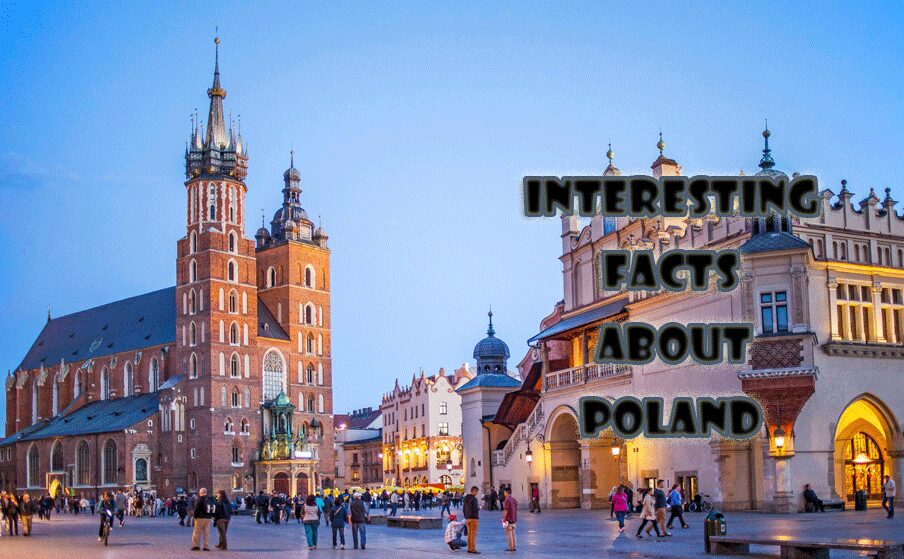Today we will help you out to know about some awesome and interesting facts about Poland, you will be amazed after reading these interesting facts about Poland.
Interesting facts about Poland
Land, People & Culture
- Poland is the 6th most populous and the 6th largest of the European Union’s 27 member states. Most of the country is flat, with an average elevation of 173 meters.
- 90% of Poles have completed at least secondary education, the highest score in the EU, along with the Czechs, Slovaks, and Slovenes.
- Polish people marry the youngest within the European Union (24 years old for women and 26.5 years old for men in average).
- According to a 2007 UNICEF report on child well-being in rich countries, Poland is the second best of the 25 OECD countries surveyed in terms of “behaviours and risks” (healthy lifestyle, lack of violence), and third best for educational well-being. The same reports also finds that Poland has the lowest pecentage overweight young people (7.1%) and the lowest percentage of teenagers under 15 who had had sexual intercourse (15.1%). However, Poland also had the highest number of young people aspiring to low skilled work (17.1%).
- Polish people have the largest households in the European Union.
- Poland is the poorest country in the EU after Bulgaria and Romania in terms of GDP per capita at PPP.
History
- In ancient times, what is now Poland was inhabited by a multitude of ethnic groups, including various Celtic, Slavic (in the centre and south-east), Baltic (in the north-east) and Germanic (in the west and south-west) tribes.
- The country’s first historically documented ruler was Mieszko I (c. 935-992), Duke of Polans (a territory roughly equivalent to modern Poland).
- Polish born astronomer Nicolaus Copernicus formulated the first explicitly heliocentric model of the solar system, thus starting the scientific revolution that would transform Europe and weaken the dogma of the Catholic Church. Ironically, Poland is nowadays one of the most staunchly Catholic country in Europe.
- Another Polish astronomer, Johannes Hevelius (1611-1687) published the earliest exact maps of the moon.
- Stanislaw Leszczynski (1677-1766), King of the Polish-Lithuanian Commonwealth (1704-1709 and 1733-1736), was the father-in-law of Louis XV of France. He was became (the last) Duke of Lorraine after losing the throne of Poland. He gave his name to a World Heritage city square in Nancy, the then capital of the Duchy of Lorraine.
- One of Napoleon I’s most famous lovers was Marie Walewska (1786-1817), a Polish countess who influenced the Emperor to create the Grand Duchy of Warsaw (1807-1813).
- The last independent King of Poland abdicated in 1795. The core of the country became the Grand Duchy of Warsaw under the protection of Napoleon I. Between 1815 and 1918, Poland ceased to exist as a politcal entity, and was divided between Russia, Prussia (then Germany), and the Austro-Hungarian Empire.
- In 1939, Poland had the largest Jewish community in Europe (almost 3.5 million). This may be why 70% of the Nazi extermination camps during WWII were located in what is now Poland, including the three most infamous ones : Auschwitz-Birkenau, Treblinka and Belzec (each with an estimated number of deaths over 600,000).
- About one third of modern Poland used to be ethnically, culturally and linguisticallly German.
- Silesia (in the south-west of Poland) was settled in ancient times by the Lugii, an originally Celtic tribe that was became Germanised over time. The region swore allegiance to the Holy Roman Emperor in 1355 C.E. Although it had a large ethnic Slav community, the region became predominantly German-speaking during the Middles Ages, due to immigration from Germany.
- In the north-west of modern Poland, Pomerania is a region settled by Germanic tribes since ancient times, which stretches all the way between Gdansk (Danzig) and Stralsund, in East Germany.
- he north-east of Poland constitues the historical region of Prussia, which was originally settled by Baltic people, but controlled by the Teutonic knights since the 13th century, and progressively Germanised.
- The Duchy of Prussia merged with the Margriaviate of Brandenburg (around Berlin, in East Germany) to form the Kingdom of Prussia in 1701, which progressively unified Germany and created the Second Reich in 1871. So it can be said that Germany was unified under the name of a historical area (“Prussia”) being now entirely in Poland.
- Pomerania, Prussia and Silesia were ceded by Germany uto Poland as war reparations in 1945, but had been ethnically and culturally German for many centuries (for longer than the Americas have been colonised by Europeans).












